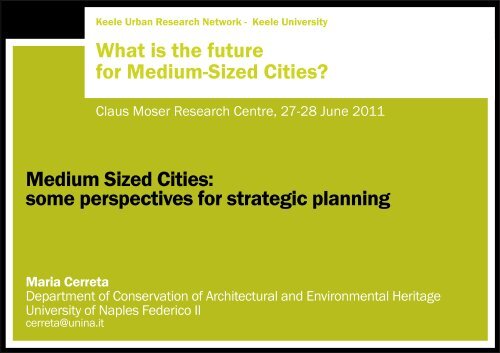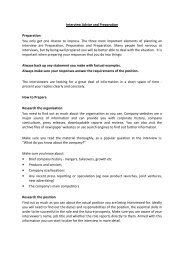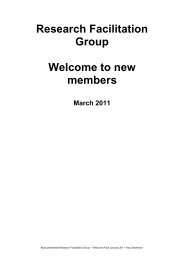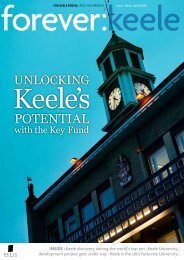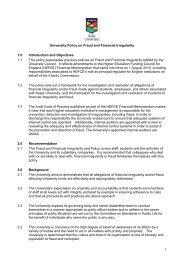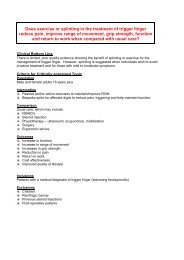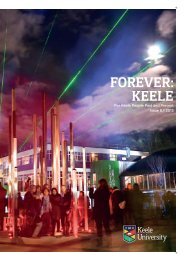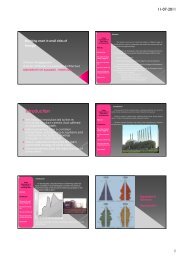Cerreta presentation - Keele University
Cerreta presentation - Keele University
Cerreta presentation - Keele University
You also want an ePaper? Increase the reach of your titles
YUMPU automatically turns print PDFs into web optimized ePapers that Google loves.
<strong>Keele</strong> Urban Research Network - <strong>Keele</strong> <strong>University</strong><br />
What is the future<br />
for Medium-Sized Cities?<br />
Claus Moser Research Centre, 27-28 June 2011<br />
Medium Sized Cities:<br />
some perspectives for strategic planning<br />
Maria <strong>Cerreta</strong><br />
Department of Conservation of Architectural and Environmental Heritage<br />
<strong>University</strong> of Naples Federico II<br />
cerreta@unina.it
Medium Sized Cities:<br />
some perspectives for strategic planning<br />
1. Medium Sized Cities:<br />
Sustainability or Self-Sustainability?<br />
2. Integrated Assessments:<br />
thinking through complex values<br />
3. Strategic spatial planning<br />
as a field of practices
Medium Sized Cities:<br />
some perspectives for strategic planning<br />
1. Medium Sized Cities:<br />
Sustainability or Self-Sustainability?<br />
2. Integrated Assessments:<br />
thinking through complex values<br />
3. Strategic spatial planning<br />
as a field of practices
Informality<br />
Labour<br />
markets<br />
Cityness<br />
1. Medium Sized Cities:<br />
Sustainability or Self-Sustainability?<br />
Architecture<br />
Transport<br />
Urban<br />
form<br />
Social<br />
justice<br />
City-Regions<br />
Urban<br />
economy<br />
Density<br />
Security<br />
Retrofitting<br />
Community<br />
Planning<br />
Urban Age Glossary (UCL, 2007)<br />
Neighbourhoods<br />
Economic<br />
development<br />
Globalization<br />
Speed<br />
Governance<br />
Equality<br />
Risk<br />
Social<br />
cohesion<br />
Migration<br />
Mobility<br />
Public<br />
space<br />
Housing<br />
Scale
Medium<br />
Sized<br />
City<br />
1. Medium Sized Cities:<br />
Sustainability or Self-Sustainability?<br />
a population of 20,000 up<br />
to 200,000, depending on<br />
population density and the<br />
respective urban system in<br />
a country<br />
(Kunzmann, 2010)<br />
How<br />
Geographical location<br />
Different functions<br />
Territorial capital
1. Medium Sized Cities:<br />
Sustainability or Self-Sustainability?<br />
territory<br />
values<br />
resources<br />
society<br />
good governance<br />
social<br />
sustainability<br />
environment<br />
sustainable<br />
development<br />
environmental<br />
sustainability<br />
economy<br />
economic<br />
sustainability<br />
territorial<br />
sustainability<br />
political<br />
sustainability<br />
characterised by<br />
participation, transparency,<br />
accountability, rule of law,<br />
effectiveness, equity
environment<br />
1. Medium Sized Cities:<br />
Sustainability or Self-Sustainability?<br />
economy<br />
society<br />
environment<br />
economy<br />
society<br />
environment<br />
economy<br />
society<br />
Increasing integration of environmental, social and economic<br />
dimensions in policies, plans and programmes and evaluation<br />
of the inter linkages (OECD, 2006)
What means<br />
sustainability<br />
for<br />
medium sized<br />
cities?<br />
Knox and Mayer, 2009<br />
1. Medium Sized Cities:<br />
Sustainability or Self-Sustainability?<br />
Growth/Decline - Challenges and Issues<br />
Equity<br />
Housing affordability<br />
Land use pressures<br />
Environment<br />
Environmental degradation<br />
Politics of growth and<br />
environmental quality<br />
Cultural landscape<br />
Economy<br />
Increasing service reliance<br />
Homogenisation of retail sector<br />
Dependance on other communities<br />
for jobs<br />
Culture and community<br />
Threatened sense of place<br />
Commodified identity and culture<br />
Increasing community capacity<br />
Equity<br />
Decline in public service provision<br />
Environment<br />
Neglect of cultural landscape<br />
Vacant land use<br />
Economy<br />
Resource-based/old economy in<br />
decline<br />
Lack of growth opportunities<br />
Culture and community<br />
Vacant and abandoned housing<br />
Lack of animation in politics<br />
Social isolation<br />
Ageing demographics
property<br />
conflict<br />
1. Medium Sized Cities:<br />
Sustainability or Self-Sustainability?<br />
Economy<br />
overall economic growth<br />
and efficiency<br />
Equity<br />
sustainable<br />
development<br />
green, profitable, fair<br />
resource conflict<br />
social justice, economic opportunity, income equality<br />
Environment<br />
development<br />
conflict<br />
The complexities<br />
and ambiguites involved<br />
in the interdependencies<br />
among the three Es<br />
can lead to a kind<br />
of despairing inertia<br />
environmental protection
Mobilising<br />
for change<br />
1. Medium Sized Cities:<br />
Sustainability or Self-Sustainability?<br />
Approaches<br />
Characteristics<br />
Mainstream<br />
(fast)<br />
Homogenised<br />
Single imperative<br />
Inequitable<br />
Industrial<br />
Standardised<br />
Corporate<br />
Unsustainable<br />
Copied<br />
Low quality<br />
Replicable<br />
Intensive to local<br />
history and culture<br />
Alternative<br />
(slow)<br />
Idiosyncratic/<br />
Asset specific<br />
Multiple<br />
imperatives<br />
Equitable<br />
Craft<br />
Customised<br />
Grassroots<br />
Sustainable<br />
Authentic<br />
High quality<br />
Asset specific<br />
Sensitive to local<br />
history and culture
Towards a typology of<br />
medium-sized towns<br />
Location<br />
In a metropolitan<br />
region<br />
In between or<br />
on the edge of a<br />
metropolitan region<br />
In the periphery<br />
of metropolitan<br />
regions<br />
At an inner or outer<br />
European border<br />
Function Supply<br />
and stabilization<br />
Daily and weekly<br />
consumer goods<br />
and services<br />
Public services<br />
(education, health,<br />
social services,<br />
affordable housing,<br />
justice, security,<br />
culture, leisure)<br />
Daily and weekly<br />
consumer goods<br />
and services<br />
Public services<br />
(education, health,<br />
social services,<br />
affordable housing,<br />
justice, security,<br />
culture, leisure)<br />
Daily and weekly<br />
consumer goods<br />
and services<br />
Public services<br />
(education, health,<br />
social services,<br />
affordable housing,<br />
justice, security,<br />
culture, leisure)<br />
Logistic<br />
distribution,<br />
cultural exchange,<br />
intercultural<br />
communication<br />
Development<br />
SMEs<br />
Knowledge<br />
industries<br />
Creative industries<br />
Single large industries<br />
in traditional location<br />
SMEs<br />
Special functions<br />
based on local profile<br />
and assets (furniture,<br />
food, health)<br />
Local potentials<br />
(tourisms, recreation,<br />
leisure)<br />
SMEs<br />
Knowledge<br />
industries<br />
Creative industries<br />
Logistics<br />
Customs services<br />
Decentralisation<br />
and relief<br />
Back offices<br />
Qualified services<br />
for national<br />
customers<br />
Creative industries<br />
Not relevant<br />
However<br />
Erosion of function<br />
in small towns,<br />
shifted to the<br />
medium-sized town<br />
Not relevant<br />
However<br />
Erosion of function<br />
in small towns,<br />
shifted to the<br />
medium-sized town<br />
Not relevant
cittaslow<br />
criteria<br />
1. Medium Sized Cities:<br />
Sustainability or Self-Sustainability?<br />
Environmental<br />
Planning<br />
Urban Design<br />
ISO Certification<br />
Recycling<br />
Composting<br />
Protection of Drinking<br />
Water<br />
GMO Free Landscape<br />
Ecological Land Use<br />
Planning<br />
Protection of Cultural<br />
Landscape<br />
Alternative Energy<br />
Climate Change<br />
Strategy<br />
Plastic Bag Free Town<br />
Organic Food<br />
Infrastructure<br />
Planning<br />
Planning for Public<br />
Transportation<br />
Cittaslow Awareness<br />
Participatory Local<br />
Politics<br />
Cittaslow Working<br />
Groups<br />
Local Food in School<br />
Cafeterias<br />
Promotion of Family<br />
Life and Recreation,<br />
and Activities for<br />
Seniors<br />
Urban Quality<br />
Downtown<br />
Revitalisation<br />
Historic Preservation<br />
Trash Management<br />
Green Buildings<br />
Social Equity<br />
Healthy Region<br />
Initiative<br />
Buy Local Campaign<br />
Conviviality<br />
Parking Management<br />
Tourism Strategy<br />
Food Festivals<br />
Cittaslow<br />
Pubblications<br />
Special Projects
Building on local<br />
comparative<br />
advantages<br />
Promoting<br />
"third places"<br />
1. Medium Sized Cities:<br />
Sustainability or Self-Sustainability?<br />
Will Small-Medium Cities make a difference?<br />
It depends on approaches based on a platform of intersecting<br />
and mutually reinforcing local initiatives, a combination of:<br />
Promoting local<br />
sense of place<br />
Taking care of the<br />
physical fabric of<br />
the town<br />
Promoting rhythm<br />
and seasonality<br />
Promoting ecofriendly<br />
behaviours<br />
and renewable<br />
energy systems<br />
Promoting local<br />
products<br />
Making long-term<br />
investments in the<br />
community's<br />
infrastructures<br />
Promoting<br />
outdoor activities<br />
Involving local<br />
business leaders,<br />
community<br />
groups, local<br />
government
1. Medium Sized Cities:<br />
Sustainability or Self-Sustainability?<br />
Self-Sustainability as "strategy"<br />
Any self-sustainable system must secure,<br />
enhance and preserve communication and<br />
coordinated action, among its components<br />
or agents.<br />
It must also overlook their coordination and<br />
self-coordination competencies.<br />
Degradation<br />
Self-sustaining systems must be organized<br />
so as to continually produce themselves:<br />
their own capability of their own action<br />
coordination (Zeleny, 2010). Production<br />
Bonding
Understand<br />
1. Medium Sized Cities:<br />
Sustainability or Self-Sustainability?<br />
Learning from operating<br />
Design<br />
Innovation<br />
U-D-I-O Cycle<br />
Operate<br />
Implement<br />
Both sustainability and self-sustainability are time<br />
and context dependent system properties emerging<br />
from system organization.<br />
System organization must be continually produced or<br />
renewed via operating a common, shared resource<br />
system, optimally managed through the competition<br />
and collaboration of agents.<br />
Continued functioning of the organization requires<br />
continued coordination of action, i.e.,<br />
continued production of knowledge.<br />
Data<br />
Information<br />
Knowledge<br />
Wisdom<br />
Know-Nothing<br />
Know-What<br />
Know-How<br />
Know-Why
Value<br />
created<br />
1. Medium Sized Cities:<br />
Sustainability or Self-Sustainability?<br />
Value for<br />
customer<br />
Value for<br />
business<br />
Profit<br />
Wages and salaries<br />
Direct and indirect materials and services<br />
purchased<br />
Maximum price<br />
Price paid<br />
Cost<br />
Knowledge is measured by added value.<br />
This added value can also be interpreted<br />
as the value of knowledge engaged (Zeleny, 2010).<br />
knowledge<br />
strategy<br />
actions<br />
Medium<br />
Sized<br />
Cities:<br />
a strategy<br />
for/by<br />
actions
Specific problems<br />
Challenges<br />
Co-operation<br />
1. Medium Sized Cities:<br />
Sustainability or Self-Sustainability?<br />
Agenda<br />
setting<br />
Four tracks<br />
approach<br />
(Albrechts, 2010)<br />
Kick-off<br />
report<br />
What<br />
How<br />
Tracks<br />
1<br />
2<br />
3<br />
4<br />
Integrated<br />
Strategic<br />
Plan<br />
Transformative and<br />
integrative spatial planning<br />
Limited number<br />
of strategic key issues<br />
Why Values and meanings<br />
of 'what ought to be'<br />
Short-term up<br />
to long-term<br />
actions
Four-track<br />
approach<br />
and rationalities<br />
1. Medium Sized Cities:<br />
Sustainability or Self-Sustainability?<br />
Track<br />
1<br />
Track<br />
2<br />
Track<br />
3<br />
Track<br />
4<br />
Context of place Policy questions and issues involved<br />
Long-term vision<br />
Long-term vision and<br />
short-term actions<br />
Contact with<br />
stakeholders<br />
Basic process<br />
with citizens<br />
Value<br />
rationality<br />
Strategic<br />
rationality<br />
Communicative<br />
rationality<br />
Instrumental<br />
rationality
1. Medium Sized Cities:<br />
Sustainability or Self-Sustainability?<br />
Strategic spatial planning<br />
as a method for creating and steering a range of better<br />
futures for a place based on shared values<br />
It is a dynamic and creative process<br />
In new strategic spatial planning we envision spaces<br />
we want to live in, arousing and sustaining the actions<br />
necessary for this vision to become a reality (Goodstein<br />
et al. 1993)
1. Medium Sized Cities:<br />
Sustainability or Self-Sustainability?<br />
Strategic stabilization strategies<br />
1. Cultural traditions and local identity<br />
2. Tacit knowledge of the community<br />
3. Embeddedness of local businesses and firms<br />
4. Easy informal networking<br />
5. Übersichtlichkeit<br />
6. Entrepreneurship<br />
7. Urban-rural relationship<br />
8. International networks of memories<br />
(Kunzmann 2000)
Medium Sized Cities:<br />
some perspectives for strategic planning<br />
1. Medium Sized Cities:<br />
Sustainability or Self-Sustainability?<br />
2. Integrated Assessments:<br />
thinking through complex values<br />
3. Strategic spatial planning<br />
as a field of practices
2. Integrated Assessments:<br />
thinking through complex values<br />
evaluation<br />
of planning<br />
process<br />
evaluation<br />
for planning<br />
process<br />
evaluation<br />
within planning<br />
process<br />
planning-evaluation<br />
Recognizing the role of values means acknowledging<br />
the imperative need to move beyond the instrumental<br />
aspects of practice, starting from questions such<br />
as:<br />
what values? whose values? values for whom?<br />
values based on what point of view?<br />
values based on what kind of priority?<br />
The value-focused thinking approach considers as<br />
an essential assumption a multi-dimensional vision<br />
of value, a complex perspective, according to which<br />
it is possible to integrate values belonging to<br />
different and multiple dimensions.
Cultural<br />
resilience<br />
2. Integrated Assessments:<br />
thinking through complex values<br />
Tangible and intangible<br />
relationships<br />
Interpretation/<br />
comparison<br />
=<br />
Evaluation<br />
New values<br />
Critical knowledge<br />
Creativity<br />
Thinking through complex values means thinking<br />
across boundaries, considering soft spaces and<br />
fuzzy boundaries, overcoming different kinds of<br />
limits, and having plural insights in order to<br />
formulate a situated strategy (Liew and Sundaram<br />
2009) addressing a situated decision problem.<br />
Creativity<br />
Human sustainable<br />
development<br />
Resilience Sustainability<br />
Tangible and intangible values
2. Integrated Assessments:<br />
thinking through complex values<br />
An integrated approach has to consider:<br />
Human, social,<br />
environmental,<br />
economic,<br />
institutional<br />
capital<br />
Territorial<br />
identity/<br />
Context<br />
peculiarity<br />
Shared vision Complex values<br />
Dynamic<br />
interaction/<br />
Collective<br />
learning<br />
Assessment/<br />
Evalutaion<br />
as<br />
creative tool<br />
Assessment/Evaluation and Planning =<br />
needs a constant interaction in processes of spatial<br />
transformations (policies, plans, programmes, projects)
2. Integrated Assessments:<br />
thinking through complex values<br />
Requirements<br />
emerging problems<br />
needs of inhabitants and communities<br />
scarcity and exploitation of resources<br />
role in wider context at different levels<br />
Components<br />
historical<br />
cultural<br />
environmental<br />
economical<br />
social<br />
anthropological<br />
Integrated assessments<br />
as a tool for a balance<br />
between<br />
conservation and<br />
transformation<br />
in the respect of<br />
values and resources<br />
Levels of analysis<br />
Dimensions of evaluations<br />
Overcoming spatial limits and hierarchies<br />
Weights/Priorities<br />
Green strategies<br />
'oriented' knowledge<br />
social/public participation<br />
interdisciplinary/integration<br />
activation/actualization
2. Integrated Assessments:<br />
thinking through complex values<br />
Integrated evaluation approaches may enable the interpretation<br />
of material and immaterial relations characterizing a context,<br />
the acknowledgement of existing tangible and intangible<br />
values, and the creation of strategies aimed at the production<br />
of new values and at the sustainable development of many<br />
local resources in a multi-dimensional perspective.<br />
There is a need for developing useful models of contingent<br />
situated application, facilitating the development and<br />
institutionalization of complex multi-method evaluation systems,<br />
which take into account specific purposes and are linked to the<br />
specific context.
Decision<br />
stakes<br />
high<br />
Post-normal<br />
Science<br />
Professional<br />
Consultancy<br />
Applied<br />
Science<br />
low<br />
2. Integrated Assessments:<br />
thinking through complex values<br />
The environmental/social/political choices<br />
are often characterised by uncertainty,<br />
values in dispute, high stakes and urgent<br />
decisions.<br />
They can be dealt with a new epistemological<br />
structure called Post-Normal Science (Funtowicz<br />
and Ravetz, 1991), in which we consider two<br />
crucial aspects of the science: uncertainty and<br />
conflict of values<br />
high<br />
Systems<br />
uncertainties<br />
Post-Normal<br />
Science<br />
Ecological<br />
Economics<br />
An integrated approach should<br />
define 'more satisfying'<br />
performances of scenarios in<br />
relation to perceptions of different<br />
stakeholders, taking into account<br />
not only economic, technical,<br />
ecological and institutional<br />
limitations, but also political<br />
feasibility and social acceptability<br />
of proposed solutions, answering<br />
the emergent requirements coming<br />
from implementation processes
2. Integrated Assessments:<br />
thinking through complex values<br />
Decision Analyst<br />
Problem<br />
structure<br />
Decision Support Model<br />
System/<br />
alternatives<br />
Uncertainity/<br />
Sensitivity analysis<br />
Stakeholders<br />
Values and<br />
preferences<br />
Experts<br />
input<br />
interaction<br />
Not structured problems<br />
> multiplicity of actors<br />
> multiplicity of points of view<br />
> incommensurable interests<br />
and or in conflicte<br />
> important intangible values<br />
> uncertainty<br />
> risk
Environmental<br />
Assessment (EA)<br />
the 'umbrella<br />
term' for<br />
the process<br />
of examining the<br />
environmental<br />
risks and<br />
benefits of<br />
proposals at<br />
different levels<br />
and scales<br />
2. Integrated Assessments:<br />
thinking through complex values<br />
Strategic<br />
Environmental<br />
Assessment<br />
(SEA)<br />
Environmental<br />
Impact<br />
Assessment (EIA)<br />
policies<br />
plans<br />
programmes<br />
projects<br />
SEA<br />
adaptive and<br />
continuous<br />
process<br />
focused on<br />
strengthening<br />
institutions,<br />
governance and<br />
decisionmaking<br />
processes<br />
Environmental<br />
Good Governance
Stages in planning and decision-making<br />
Source: Bina, 2004<br />
2. Integrated Assessments:<br />
thinking through complex values<br />
Model A<br />
Final<br />
decision<br />
Model B<br />
Model C Model D<br />
Final<br />
decision<br />
EIA-type SEA<br />
Focused on<br />
one stage<br />
Integrated<br />
SEA<br />
Final<br />
decision<br />
Final<br />
decision<br />
Parallel SEA<br />
Directed to<br />
several stages<br />
Compensatory<br />
SEA
2. Integrated Assessments:<br />
thinking through complex values<br />
Analytical and Decision-making Tools for Strategic Environmental Assessment<br />
1. Tools for predicting environmental and socioeconomic<br />
effects<br />
Carrying capacity analysis (CCA)<br />
Network analysis<br />
Ecological (environmental) footprint analysis<br />
Social and economic analysis/surveys<br />
Expert judgement of direct and indirect impacts<br />
Geographical information system (GIS)<br />
Land use partitioning analysis<br />
2. Tools for analysing and comparing options<br />
Mapping of transmission channels<br />
Compatibility appraisal<br />
Modelling or forecasting<br />
Cost-benefit analysis (CBA)<br />
Overlay maps<br />
Scenario analysis/sensitivity analysis<br />
Participatory techniques for assessment Multi-criteria analysis (MCA)<br />
Quality of life assessment (QoLA)<br />
Opinion surveys to identify priorities<br />
Risk analysis or assessment<br />
Vulnerability analysis<br />
3. Tools for ensuring full stakeholder engagement<br />
General information, techniques, etc.<br />
Consensus building processes<br />
Stakeholder analysis
Medium Sized Cities:<br />
some perspectives for strategic planning<br />
1. Medium Sized Cities:<br />
Sustainability or Self-Sustainability?<br />
2. Integrated Assessments:<br />
thinking through complex values<br />
3. Strategic spatial planning<br />
as a field of practices
3. Strategic spatial planning<br />
as a field of practices<br />
Sustainable<br />
spatial<br />
planning<br />
Hard data<br />
Soft data<br />
Complex<br />
social<br />
value(s)<br />
Tangible<br />
values<br />
Scientific,<br />
technical, lay<br />
knowledge<br />
Multidimensional<br />
approaches<br />
Combined<br />
approaches<br />
and tools<br />
Intangible<br />
values<br />
Integrated<br />
Assessment<br />
Integrated<br />
Spatial<br />
Assessment<br />
(ISA)
Integrated<br />
Spatial<br />
Assessment<br />
(ISA)<br />
3. Strategic spatial planning<br />
as a field of practices<br />
Hard data<br />
Soft data<br />
Shared<br />
knowledge<br />
framework<br />
Complex<br />
social<br />
values<br />
Scientific,<br />
technical, lay<br />
knowledge<br />
Problem<br />
structuring<br />
methods<br />
(PSMs)<br />
Public<br />
Participation<br />
Individual<br />
creativity<br />
Shared<br />
evaluation<br />
framework<br />
Collective<br />
learning<br />
Social<br />
creativity<br />
Multi-Criteria<br />
Analysis<br />
(MCA)<br />
Multi-Group<br />
Analysis<br />
(MGA)<br />
Geographic<br />
Information<br />
System (GIS)<br />
Sustainable<br />
choices in<br />
planning
Integrated<br />
Spatial<br />
Assessment<br />
(ISA)<br />
3. Strategic spatial planning<br />
as a field of practices<br />
Hard data<br />
Soft data<br />
Shared<br />
knowledge<br />
framework<br />
Complex<br />
social<br />
values<br />
Scientific,<br />
technical, lay<br />
knowledge<br />
potentials<br />
critical points<br />
vision 1<br />
critical points<br />
potentials<br />
Individual<br />
creativity<br />
Shared<br />
evaluation<br />
framework<br />
Collective<br />
learning<br />
Social<br />
creativity<br />
Sustainable<br />
choices in<br />
planning
MUNICIPALITY OF<br />
CAVA DE' TIRRENI<br />
VALUTAZIONE SPAZIALE INTEGRATA<br />
INTEGRATED SPATIAL ASSESSMENT<br />
MASTER PLAN<br />
Territory<br />
Structured<br />
knowledge<br />
Territory<br />
Knowledge and<br />
participated<br />
observation<br />
GIS Forum<br />
Questionnaires<br />
SODA approach<br />
Vision of future<br />
Possible<br />
transformations<br />
MCDA<br />
MCDSS<br />
AHP approach
MUNICIPALITY OF<br />
CAVA DE' TIRRENI<br />
Working group<br />
Urban planning and<br />
scientific coordination<br />
prof. Carlo Gasparrini<br />
Geomorfology<br />
dott. Silvana Di Giuseppe<br />
Agronomy<br />
dott. Maurizio Murolo<br />
Landscape<br />
prof. Vito Cappiello<br />
Economic and financial feasibility<br />
prof. Ettore Cinque<br />
Infrastructures and mobility<br />
D'Appolonia spa<br />
MASTER PLAN<br />
Strategic Environmental Assessment<br />
arch. Maria <strong>Cerreta</strong><br />
arch. Pasquale De Toro<br />
arch. Saverio Parrella<br />
Geographical Information System<br />
Ufficio di Piano, Comune di Cava de' Tirreni<br />
GIS elaborations<br />
Daniele Cannatella, Pasquale Inglese<br />
Graphic design and communication<br />
arch. Franco Lancio
MUNICIPALITY OF<br />
CAVA DE' TIRRENI<br />
MASTER PLAN
Integrated<br />
evaluation<br />
approach for the<br />
regeneration of<br />
Cava de' Tirreni<br />
city<br />
Phase 1<br />
Recognizing a decision<br />
problem/opportunity<br />
Phase 2<br />
Specifying values<br />
Phase 3<br />
Creating alternatives<br />
Phase 4<br />
Identifying strategic<br />
actions<br />
Implicit/explicit<br />
Experiential/<br />
practical<br />
Formal/informal<br />
knowledge<br />
Hard data and soft<br />
data collection<br />
Institutional<br />
Analysis<br />
Stakeholders map<br />
Situated complex<br />
social values:<br />
potentials and<br />
critical aspects In-depth interviews<br />
Focus groups<br />
Opportunities<br />
space:<br />
five alternative<br />
visions Strategic Options<br />
Development and<br />
Analysis (SODA)<br />
Multidimensional<br />
analysis:<br />
multi-criteria and<br />
multi-group<br />
Analytic Hierarchy<br />
Process (AHP)<br />
Geographic<br />
Information System<br />
(GIS)
MUNICIPALITY OF<br />
CAVA DE' TIRRENI<br />
MASTER PLAN<br />
Authorities<br />
consultation<br />
Associations<br />
and citizens<br />
consultation<br />
thematic forum<br />
questionnaires
MUNICIPALITY OF<br />
CAVA DE' TIRRENI<br />
MASTER PLAN<br />
vision 2<br />
Cava<br />
beautiful<br />
and identitybearing<br />
vision 4<br />
Cava<br />
regenerated<br />
and friendly<br />
vision 5<br />
Cava<br />
modern<br />
and<br />
productive<br />
vision 7<br />
Cava<br />
territorial<br />
hub<br />
vision 8<br />
Cava<br />
ecological
MUNICIPALITY OF<br />
CAVA DE' TIRRENI<br />
MASTER PLAN<br />
potentials<br />
vision 1<br />
critical aspects<br />
potentials<br />
critical aspects
MUNICIPALITY OF<br />
CAVA DE' TIRRENI Five shared visions: strategic cognitive map
MUNICIPALITY OF<br />
CAVA DE' TIRRENI<br />
MASTER PLAN<br />
Central analysis results<br />
Domain analysis results
MUNICIPALITY OF<br />
CAVA DE' TIRRENI<br />
5 Visions<br />
Transformation areas<br />
3 driving-projects<br />
Map of master plan situated strategies
MUNICIPALITY OF<br />
CAVA DE' TIRRENI<br />
MASTER PLAN<br />
Environmental analysis: indicators and index
MUNICIPALITY OF<br />
CAVA DE' TIRRENI<br />
MASTER PLAN<br />
Environmental analysis: indicators and index
MUNICIPALITY OF<br />
CAVA DE' TIRRENI<br />
MASTER PLAN<br />
Environmental analysis: indicators and index
MUNICIPALITY OF<br />
CAVA DE' TIRRENI<br />
MASTER PLAN<br />
Assessment<br />
of spatial<br />
impacts<br />
Struttura Hiearchical<br />
gerarchica structure<br />
GIS<br />
AHP<br />
Visions<br />
Objectives<br />
Actions<br />
Thems<br />
Indicators<br />
Sensitivity analysis<br />
Identification<br />
of transformation<br />
susceptibility<br />
Assessment<br />
scales<br />
Impacts
MUNICIPALITY OF<br />
CAVA DE' TIRRENI<br />
visions<br />
Environmental themes<br />
Criteria<br />
Biosphere Index of territorial<br />
biopotential<br />
Susceptivity to<br />
localization<br />
Values/Characteristics<br />
Value 1<br />
Value 2<br />
Value 3<br />
Value 4<br />
Value 5<br />
Score Chromatic scales<br />
Susceptivity to<br />
localization<br />
High High<br />
Medium-High<br />
Medium<br />
Medium-low<br />
Low
1. Problem scomposition<br />
2. Pairwise comparisons<br />
Biosphere Biosphere Biosphere<br />
Biosphere<br />
Biosphere<br />
Biosphere<br />
Geosphere<br />
Geosphere Geosphere<br />
Biosphere<br />
Landscape Landscape<br />
Soil<br />
Vision<br />
Biosphere Geosphere Landscape<br />
Criterium 1 Criterium 2 Criterium 3 Criterium 4<br />
Value 1 Value 2 Value 3<br />
Landscape<br />
Soil<br />
Landscape<br />
Soil<br />
Landscape<br />
Soil<br />
Soil<br />
3. Priorities vectors and consistency ratio for each vision<br />
Soil<br />
Pairwise comparisons matrix for Vision 1<br />
Pairwise comparisons matrix for Vision 2<br />
Pairwise comparisons matrix for Vision 3<br />
Pairwise comparisons matrix for Vision 4<br />
Pairwise comparisons matrix for Vision 5
Biosphere Geosphere Landscape Soil<br />
Classified<br />
raster<br />
dataset<br />
Raster<br />
map
MUNICIPALITY OF<br />
CAVA DE' TIRRENI<br />
MASTER PLAN<br />
Five visions: maps of transformation susceptibility
MUNICIPALITY OF<br />
CAVA DE' TIRRENI<br />
MASTER PLAN<br />
Five visions: maps of transformation susceptibility<br />
Struttura<br />
gerarchica
MUNICIPALITY OF<br />
CAVA DE' TIRRENI From five visions to three guide-projects
Evaluation as an instrument for:<br />
> explicating values,<br />
interesses, needs<br />
> exploring knowledge<br />
> building alternatives<br />
> identifying impacts<br />
to integrate multidimensional<br />
objectives and values<br />
to integrate approaches,<br />
methods and models<br />
to integrate reflexive and<br />
cognitive, normative and<br />
instrumental components<br />
Evaluation<br />
spatial planning field<br />
Future-oriented vision<br />
of long-period<br />
1. dynamic learning process<br />
2. knowledge managment<br />
3. costruction of shared choices<br />
Shared visions<br />
for an environmental<br />
good creative<br />
governance of<br />
medium-sized cities
thank you!


